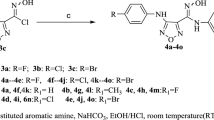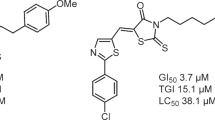Abstract
For the analysis of structure activity relationship of ar-turmerone analogues, the compounds containing the various substituents on the phenyl ring and 1(or 2)-naphthyl group in the place of phenyl of ar-turmerone were prepared and tested their cytotoxicity against HL-60, K-562, and L1210 leukemia cellsin vitro. The substituents at para position are methoxy, phenoxy, methyl, trifluoromethyl, fluoro, and chloro. Atmeta position methoxy, methyl, trifluoromethyl, or chloro groups and atortho position methoxy or chloro group were introduced. Against HL-60 and K-562 cells, ED50 values of the analogues are ranged from 0.8 to 30.0 μg/ml. Against L1210 cell, these are located more than 20.0 μg/ml. However, 5-carboethoxy-2-methyl-6-(1-naphthyl)-2-octen-4-one (5n) possesses ED50 valuses 0.8, 2.1, 6.5 μg/ml against HL-60, K-562, L1210 cells, respectively. The electronic nature of the subsituents on phenyl ring of ar-turmerone dose not affect the biological activity. Therefore the flat structure of aromatic portion of ar-turmerone analogues is the more important factor for their activity rather than its electronic nature. The potentiation of the cytotoxicity with the enlargement of aromatic ring region also supports the importance of the plane structure of this area. The restriction of the single bond rotation between C-6 and aromatic ring through the introduction of substituents at theortho position of phenyl ring and the increment of size of alkyl group at C-6 position enhances the activity. Therefore the effective conformation should be the one having the orthogonal arrangement between the aromatic ring and the side chain.
Similar content being viewed by others
References lited
Ahn, B. Z. and Lee, J. H., Cytotoxic and cytotoxicity-potentiating effects of the curcuma root on L1210 cell.Korean J. Pharmacognosy, 20, 223–226 (1989).
Baik, K. U., Jung, S. H., Ahn, B. Z., Recognition of pharmacophore of ar-turmerone for its anticancer activity.Arch. Pharm. Res., submitted in 1993.
Eliel, E. L., Hutchins, R. O., and Knoeber, S. M.,Org. Synth, Coll., Vol. 6, 442–444 (1988).
Honwad, V. K. and Rao, A. S., Absolute configuration of ar-turmerone.Tetrahedron, 20, 2921–2925 (1964).
Itokawa, H., Hirayamo, F., Funakoshi, K., and Takeya, K., Studies on the antitumor bisabolane sesquiterpenoids isolated fromCurcuma xanthorriza, Chem. Pharm. Bull., 33, 3488–3492 (1985).
Kpracho, A. P., Weimaster, J. F., Eldridge, J. M., Jahngen, E. G. M., Lovey, A. J., and Stephens, W. P., Synthetic applications and mechanism studies on the decarboxylation of geminal diesters and related system effected in dimethylsulfoxide by water and/or by water with added salts.J. Org. Chem., 43, 138–147 (1978).
Lee, J. H., Kang, S. K., and Ahn, B. Z., Antineoplastic natural products and the analogues(XI)-Cytotoxic activity against L1210 cell of some raw drugs from the oriental medicine and falklore.Korean J. Pharmacognosy, 17, 286–291 (1986).
Lien, E. J. and Li, W. Y., Structure Activity Relationship Analysis of Chinese Anticancer Drugs and Related Plants, A Review, Oriental Healing Art Institute, Los Angeles, 1985, pp 10–49.
Matthes, H. W. D., Luu, B. and Ourisson, G., Cytotoxic components of Zingiber zerumbet, Curcuma zedoaria, and Curcuma domestica.Phytochemistry, 19, 2643–2650 (1980).
Oh, W. G., Baik, K. U., Jung, S. H., Ahn, B. Z., The role of substituents of ar-turmerone for its anticancer activity.Arch. Pharm. Res., 15, 256–262 (1992).
Rousseau, G. and Blanco, L., Reaction of silylketene acetals with 3,3-dimethylacryloyl chloride.Tetrahedron Letters, 26, 4195–4200 (1985).
Rupe, V. K. and Wiederkehr, F., Zur kennites des ar-turmerone aus dem cucuma-ol.Helv. Chim. Acta, 7, 654–656 (1924).
Silverman, R. B., The Organic Chemistry of Drug Design and Drug Action, Academic Press, New York, 1992. pp. 236–244, reference therein.
Thayer, P. S., Himmerlfarb, P. and Watts, G. L., Cytotoxicity assay with L1210 cellin vitro, Comparison with L1210in vitro and KB cellsin vitro.Cancer Chem. Rep., 2, 1–25 (1971).
Author information
Authors and Affiliations
Rights and permissions
About this article
Cite this article
Baik, KU., Jung, SH. & Ahn, BZ. Structure activity relationship of ar-turmerone analogues. Arch. Pharm. Res. 16, 219–226 (1993). https://doi.org/10.1007/BF02974486
Received:
Issue Date:
DOI: https://doi.org/10.1007/BF02974486




